| Frank Healy researched and wrote these historical features in 2011, with the assistance of Marianne Tan, who interviewed Betty O’Neil and Kathy DiMaio, and research from the files of the Independent Coast Observer and Gualala Arts, Inc.Photos courtesy of Betty O’Neil. |
The first show: art and garden
Most agree Art in the Redwoods began 50 years ago in 1961, but there are different versions about where it began.
Betty O’Neil and Kathy (Rubel) DiMaio, honorees at this year’s (2011) Top Hat dinner, were there. Both remember that the 1961 Art in the Redwoods took place in the Gualala Community Center.
O’Neil, an ardent gardener, was inspired to set up a show at the Community Center after attending the Oakland Flower Show. It took weeks for planning and decorating. An artificial redwood tree dominated the center of the Community Center floor. A wood framework was covered in bark donated by Norm Reuter. Fresh cut branches formed the limbs.
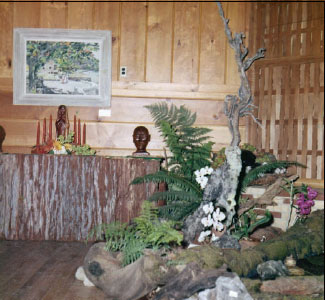
first show in 1961.
Around the central tree, flower arrangements by Jesse Cranston, Bertha Ohlson, Kathy DiMaio and Mae Enos sat on bark covered frames built to resemble tree stumps. Works from local artists hung by O’Neil were displayed along the walls.
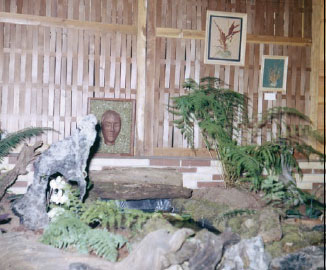
Refreshments consisted of homemade cakes and desserts served with coffee.
No prizes were awarded at that first successful event.

Like the symbolic redwood centerpiece in 1961, Art in the Redwoods has grown from a tiny idea in the minds of two women to a major annual August weekend for visitors, vendors and artists. It also is integrally linked to Gualala Arts, an organization with more than 1,600 annual activities, and it helped spur the effort to create the current Arts Center building.
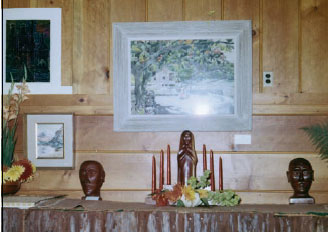
along with watercolors and oils.
In recent years the four-day event includes the Hats Off Dinner, a champagne preview, a vendor fair, and the exhibit of fine art. The origin of all these activities can be found in previous shows. The landscaped Gualala Arts Center grounds echo the garden emphasis of that first show.
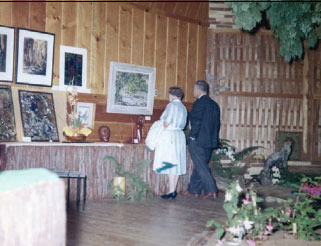
The honorees of this year’s (2011) Hats Off Dinner are most fittingly the two women who started it all – Betty O’Neil, now 85, and Kathy DiMaio, 84. Those who thought the original show was hung in the redwoods on the ridge or at Grandpa Charlie’s Park on Gualala Ridge, or in Jessie Cranston’s garden might want to come to that dinner and hear the story from this year’s honorees.
The early years
The many versions of where the original Art in the Redwoods was held stem from the fact that before finding a permanent home at its current location at the Gualala Arts Center, numerous venues were used. The successful inaugural event on the last weekend of July in 1961 was repeated the following year in the same building with a Japanese motif for the garden show concept.
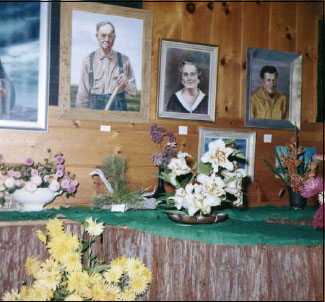
Floral displays and plant sales were a major part the first decade of Art in the Redwoods, so outdoor settings in gardens seemed quite natural. Several locals have stated that Jessie Cranston’s Anchor Bay garden and redwood grove was the original venue, but further research indicates the show moved there in its third year when art truly was hung in the redwoods.
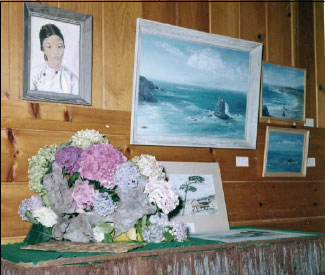
Another venue besides Cranston’s Anchor Bay garden was at the top of Pacific Woods Road in “Grandpa Charlie’s Park,” named by Dorothy and Charlie Young’s grandchildren. Eventually, problems caused by morning dew and tree resin resulted in a return to the community center.
By 1969 the Independent Coast Observer, then a monthly publication in its first year, reported Art in the Redwoods was again being held at the Gualala Community Center. The paper reported that 160 entries were being judged for painting, sculpture, and stitchery. That year the event became a two-day affair.
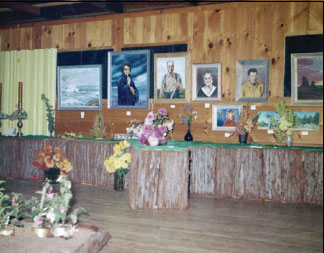
and display stands.
Local artist Michael Mathay’s metal sculpture “Birds” won the Best in Show award and Wayne McQueen’s ceramic casserole took second prize. The garden aspect continued with a sale of flowering plants suitable for the local climate. A hot lunch was available and admission for adults was 50 cents.
Even before Art in the Redwoods started, Gualala Arts was formed to promote local artists and to provide a social venue for its members who organized Art in the Redwoods and exhibited both flowers and art pieces there. Through the sale of plants and food, Art in the Redwoods became a means to raise money for Gualala Arts, which became a 501(c)(3) corporation in 1965.
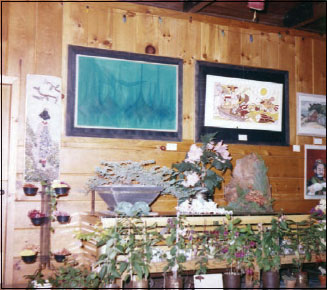
Although details about the early years remain sketchy, Art in the Redwoods definitely became an annual summer fixture that grew bigger every year. To this day many features remain. Judges from the outside art world judge the entries and cash prizes are awarded. The annual raffle always offered a quilt as the grand prize. The date became the third weekend in August. Local businesses started sponsoring various awards.
To become a member of Gualala Arts Click here
Art show grows into new home
The 15 years from 1970 to 1985 saw the Art in the Redwoods festival grow larger and more encompassing in downtown Gualala. The proceeds were then dedicated to supporting art programs and promising art students at Point Arena High School.
The garden show remained a key aspect and artistic floral arrangements competed with the art work. In 1972 the local paper, now published twice a month, reported in a full page spread that 500 visitors viewed 125 entries. The Gualala Lions Club, which still staffs the beverage booth, was involved even then. Club members cooked a venison barbecue with corn prepared by Bob Anderson. Ida Bower handled the cash box.
Prizes were awarded in a number of categories with both an Adult and Children Division. The Best in Show award of $100 went to Peter Hetchman, a College of Marin art student who had a summer job as an aide at the county park. Other awards went to second and third place winners, to the Most Popular piece and for Best Local Entry.
Reflecting the times, Mae Enos dubbed her 1972 committee that sold topiary trees, living plaques and potted plants “The Flower Children.” The 1976 show had a historical works theme and Betty Montague’s painting of the Gualala Hotel entitled “Late Afternoon Stage” won a prize.
In 1977 Jim Lotter, fair coordinator, introduced a crafts fair with 20 artisans selling pottery, jewelry and other crafts. By 1981the festival, extended over two weekends, had 220 entrants, and included a Young Artist Exhibit.
An MTA bus shuttled visitors from the Community Center’s Three-Dimensional Art show to an Invitational Artists Exhibit at the Old Milano Hotel intended to demonstrate the high quality of work produced locally. Heidi Endemann and Millard Sheets were among those featured. John and Ann Terry’s hot-air balloon offered a birds-eye view of the town.
In the 1980s, Art in the Redwoods included venues at the Community Center, the Brown House (where Pay-n-Take is now housed), and The Dolphin. There were three shows – The Invitational Show, The Open Show and The Youth Show. A number of businesses sponsored various prizes.
A covered outdoor cafe in various guises adjoined the Community Center. One year the “Redwood Garden” featured wine tasting with complimentary glasses, another year featured beers with monogrammed mugs. One year Le Cafe Foret provided food and another The Food Company catered the event.
The Alliance for Coast Music and Dance produced theatrical performances like the performance of Pirandello’s Caps and Bells in 1982. In 1984 Le Bonheur, Highway 1 Jazz Choir, and a barbershop quartet presented what the ICO called “a coastal music sampler.”
This era culminated in the mid ’80s.The 1984 weekend kicked off with an Artists Ball held in the Gualala Hotel. Art work was previewed and judged on the Friday before the opening. The Garden Show was held in the not yet completed Sundstrom Mall building.
Five judges included commentary on the pieces entered in 14 categories. Winners were displayed in the capitol rotunda in Sacramento for the month of September under the sponsorship of the California Arts Council. Karel Metcalf’s quilt was judged Best in Show.
The last year Art in the Redwoods was held downtown was 1985. That year had 400 entrants with the still unfinished Sundstrom Mall used for the main exhibit area. The Dolphin, now located in Gualala, housed the Young Artist show and the Community Center was the site of the floral entries, garden shop and cafe. Artists demonstrated scrimshaw, stained glass, spinning and darkroom and pottery techniques. Nature photographer Al Wool showed two of his documentary films, Roaming the California Coast Range and California Coastline. From its modest beginnings, the annual fixture had expanded to encompass the entire downtown.
On the Ridge: 1986 – 1998
In 1986 the weekend summer highlight had relocated to the commercial complex at the Ocean Ridge airport where Gualala Arts rented space for the “temporary art center.” Later, a “Big-Top” tent erected next to the building housed the artwork. Vendor booths, performances and a barbecue were located across the street in Bower Park.
Karel Metcalf, then Gualala Arts director, remembers, “When we moved to the ridge we actually had the show entirely in the building for a couple of years. Then, we used the tent and hauled in pine chips to cover the floor. We had to take down the art works when the fog came in at night to keep them dry.”
That 1986 weekend was remarkable not only because the event left the downtown area, but locals fondly recall the first Summer Faire with a Renaissance theme. The Thursday Night “Feast and Frolic” dinner took place at the Gualala Hotel followed by an evening of dancing at The Breakers across the street.
Jan Harris, Alan Francis and Mike Mortensson, Sea Ranch Association Community Manager, produced the Renaissance Faire. Harris produced a series of scenes from Shakespeare’ Hamlet, Henry IV, Part 1, Midsummer Night’s Dream, and Taming of the Shrew.
A craft show where no modern materials were allowed, the Coast Recorder Consort in Elizabethan garb, and grilled British bangers carried out the theme. The plant sale was held at a play structure in the park that was transformed into a Tree of Plants. Children had their own stage for improvised performances and there was a story teller.
The following year continued the Midsummer Faire idea. This time material used to sew the banners and tunics worn by volunteers in the booths came from 1976’s Christo Running Fence. The Bower Park stage was the setting for non-stop entertainment throughout this period that included solos, duets, trios, quartets and quintets as well as puppet shows and more dramatic performances.
On New Turf was an original play performed that year. A barbershop quartet called Fungi, pronounced “Fun Guys,” was an annual fixture. The 1988 Art in the Redwoods included a Dinner Theater night at the Community Center where Bloodline or Hanged in Their Own Family Tree was performed. An evening of food and entertainment continued in various guises throughout the ’90s.
In 1989, Public Sector belted out Reggae in the barbecue area. The 1991 festival included a 7 p.m. sold out supper show at the Community Center that featured The White Water Wailers. The raffle prize was still a quilt, but the money raised once again supported Gualala Arts.
Many remember the Rolling Sculpture Vintage Car Show first introduced in 1993 that continued through 1996. Gualala netsuke artist David Carlin included his collection of 500 miniature cars. Some time in the ’90s many recall an impromptu air show that occurred when a pilot flew in and performed some stunts above the airport.
In 1995, the ICO’s newly introduced Splash section published for the first time a program insert that included a complete list of entrants in 17 separate categories. That program included drawings of the proposed Gualala Arts Center. The 1996 Art in the Redwoods was the last to be held on the ridge. Those attending were invited to tour the Gualala Arts Center construction site.
This era came to an end in 1997 when Art in the Redwoods moved to its present location. That year, The Dolphin offered signed commemorative posters of the building, created by Duane Gordon, for $22. Ocean Song was the site of the Friday Night Dinner and Opera Fresca performed at the Gualala Community Center on Saturday evening. Robert Holmes unveiled his bronze sculpture Spinning Dancers.
The idea spawned in Richard and Fiona Perkins’ living room in the early 1960s grew until a host of volunteers, generous donors and visionary community leaders made the Gualala Arts Center a reality. Art in the Redwoods is the showcase for the local art community and a source of revenue that helped make the beautiful venue visitors see today. Art in the Redwoods found its permanent home in the redwoods.
The Gualala Arts Center today
Visitors to this year’s Art in the Redwoods will admire the attractive building and grounds located in a beautiful grove of redwoods, but many will not know the story of how it all came about.
Since its inception in the early 1960s as an independent offshoot of Mendocino Arts, Gualala Arts has promoted local artists and related social events. From its beginning it sponsored classes in art related subjects and supported student artists.
The vision of a permanent home was not envisioned by the original organizers, but it was by Elizabeth Bemrick, who organized and ran The Dolphin in the early days at Anchor Bay and later in downtown Gualala. She kept the idea of a permanent home alive despite a lot of resistance from those who wanted to just rent the Gualala Community Center for events like Art in the Redwoods.
Bemrick found a lot on Ocean Ridge Dr. but that location and another on Pacific Woods Rd. never gained Gualala Arts Board support. When the St. Orres two-plus acre property with the unfinished building became available, many thought it an ideal location for an art center. But that location was rejected as were several others.
After 18 years of fund raising that included major donations from Peter Mohr, the Irvine Foundation, Elaine Jacob, Alan and Janet Coleman and many, MANY others, enough money was available to make Bemrick’s dream viable.
The communities of Gualala and its neighbors have given not only financial support, but also building materials, equipment and supplies and countless hours of volunteer labor.
In 1990 that dream become a reality when Dr. Ollie Edmonds of Gualala Redwoods gave the present 10-plus acre site to Gualala Arts.
Plans for the 15,000 ft. facility formed. Construction began in March 1996 and the Arts Center was dedicated in 1998. Paul Styskal was the building designer; the Building Committee Chair was Bill Ackermann; Alan Coleman and Lee Rye served as Co-Chairs of the Fund Raising Committee between 1989 and 1999.
Karel Metcalf was the full-time Executive Director from 1988 until 2004. Construction began with additional help from copious volunteer labor in 1996 and the building was dedicated in 1998, the first year Art in the Redwoods took place at its current location.
The building is debt free but fundraising continues to enable programming, operations and much needed maintenance.
Besides the more than 300 volunteers, Gualala Arts currently has a dedicated staff headed by David “Sus” Susalla, Executive Director since 2004 and he joined the staff January 1, 2002.
The current home office team consists of Kendra Stillman, Office & Publicity Manager; Jane Kelly, Bookkeeper; Scott Cheiffo, Operations Manager; Andrea Allen, Sales Assistant. The building has a 300 seat capacity auditorium, stage with dressing rooms, commercial kitchen, control room, conference room, library, ceramics studio, permanent gallery, amphitheater with stage, picnic area with barbecue pits and wood-fired pizza oven, two terraces, and landscaped grounds with meditation grove and hiking trails.
The facilities are available for rental for weddings and private social events. Many other community activities also take place there.
The idea nurtured by Elizabeth Bemrick and helped by so many others has become a cornerstone of the Redwood Coast community and has succeeded far beyond anyone’s expectations. With the same dedication and energy shown over the last 50 years, Gualala Arts will accomplish even more on its 100th anniversary.
To become a member of Gualala Arts Click here
 Gualala Arts Promoting public interest and participation in the arts since 1961
Gualala Arts Promoting public interest and participation in the arts since 1961